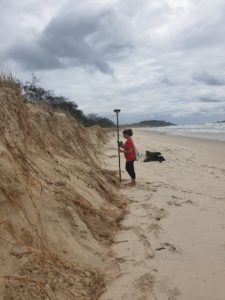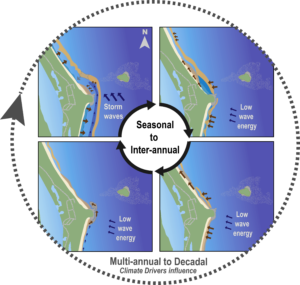Griffith University researchers haverevealedthe cyclic processes that drive the movement of sand around coastal headlandsandpreventbeacherosion.

PhD candidate Ana Da Silva.
Published in theScience of the Total Environment,researchers from theCoastal & Marine Research Centreand the School of Engineering & Built Environment assessed 30 yearsof sand movement around Fingal Head (New South Wales, Australia), discoveringthatstorm-driven waves and sediment availabilityfacilitatedsand bypassing headlands, both of whichweresusceptible to climate change.
“Powerful erosion eventscan occur all along the Eastern Australia Coastlinewhen conditions prevent migrating sand frombypassingheadlands,”saidPhD Candidate,Ana Da Silvafrom theCoastal and Marine ResearchCentreat Griffith University.
“ThisstudyofFingalHeadgives us a better understanding of the natural process of sand migration around headlands and its interaction withweather, waves, andclimate drivers such as El Niño/La Niñaandhow thesechangeover seasons, yearsanddecades.
“Fingalheadlandis the last obstruction tosand migrating northalong the Eastern Australia Coast before the Artificial Tweed Sand Bypass,which pumps sandtothesouthernend of theGold Coast.Failureofsand to bypass Fingal could haveconsequences forthe managementof Gold Coast beaches and potentially lead to erosion.”
Partneringwith the NSW government, the researchersphysically mappedthe sands movements over a year and a half,and alsoanalysedmore than30 years of satellite imagesto constructanunprecedented dataset to investigatethe processesdrivingsandmigratingaroundheadlands.
“We mapped the shapeand depth(topography and bathymetry) of the beach andthesurf zoneseafloorusing a very accurate GPS unit and fish findermounted to aresearch jet-ski,”saidDrTom Murray, research fellow from the Coastal and Marine ResearchCentre.
“The Coastal and Marine Research Centreresearchjet-ski is the only researchoneof its kind in Queensland and our field team has hundreds of hours experience operatinginthesurf zonecollectingdatawherebreakingwaves and surfersmake this data collectionmore challenging.”

The hybrid headland bypassing concept of Fingal Head.
For the first time, researchers discovered that the movement of sand bypassing Fingal headland occurred via two separate processes.
“The sandbar-driven bypassing scenario requires a storm eventwithhigh wave energy from the southeast,typicalof cyclone conditionsfrom late summer to autumn,which buildsasandbar system and over seven months completesthe fullsandbypassing cycle,”Ms Da Silvasaid.
“A quicker bypassing cycle happens over a few months when there is a large volume of sand available to the south – it simply leaks around the headland following persistent low energy wave conditions, which tends to occur around spring to early summer.”
The three decades of data showthat La Niña years weren’tfavourableto the sand bypassing the headland,and lead toerosionof thebeaches to the north and south.Alternatively, El Niño years triggered one of the threecycles of sand bypassing Fingal Head thatlasted around 5-6 years.
“Predictedclimaticchangeswillalter the frequencyand direction of storm-driven waves onthe Easterncoast ofAustralia, and thus the rate ofsand bypassingaround Fingal and other headlands,” MsDa Silva said.
“Understanding thelinkbetween the headland bypassing ratesat Fingal Head and large-scale climate drivers iscrucially importanttobe able toforecastand managethe process in the future.”

